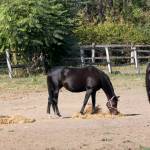Keep Horses on Limited Turnout Happy and Healthy

There are many reasons to keep a horse in a drylot or small yard. Maybe he’s a chubby equine that needs to lose some weight, or else his pasture access must be restricted because of sensitivity to carbohydrates in grass. Confinement might be a temporary measure while an owner reseeds a larger turnout area, quarantines a newly arriving horse, or waits for an injured pony to heal. In any case, a horse in a drylot may be missing space to exercise, friends to hang out with, fresh grass to eat, and the sensory stimulation available to horses roaming a large pasture with varied sounds, sights, and terrain.
Owners probably can’t turn a small drylot into an equine amusement park, but with a little imagination, they can provide some relief from boredom by making a few drylot improvements. Think about these possibilities if you’re designing a new drylot or sprucing up an existing one.
Exercise space. Almost by definition, drylots aren’t very large. If you can’t add length or width, you can increase movement by feeding hay in a couple of locations, spacing small piles throughout the area rather than piling the day’s supply in one spot. Water should be in still another place so the horse must move a bit to access it. To encourage mild exercise for a sound horse, think about adding a small mound of dirt to climb, a patch of sand to roll in, and a short section of fence that the horse must walk around to reach hay or water. In choosing a site for a new drylot, consider using an area with a hill, a rocky ledge, or some other feature that breaks up the landscape.
Social stimulation. Think about ways to provide the drylotted horse with some company. Bring another horse into the drylot for a few hours each day, or get a buddy (pony, goat, sheep) for the confined horse. If these options aren’t possible, at least situate the drylot in sight of other horses or close to a barn where other horses are brought in and out frequently.
Combating boredom. Your horse will stay more content in the drylot if there’s something to do besides just standing around all day. Using slow-feeder haynets will stretch out eating time and avoid long periods when the horse has nothing to nibble. Adding toys like playballs, a large plastic barrel, or a scattering of logs will allow an inquisitive horse to explore these objects, especially if you rotate them in and out of the drylot.
A healthy environment. Keep to a frequent schedule of picking up manure, scrubbing the water tank, and checking fences. If possible, add a shelter for shade in summer and as a windbreak in winter. Finally, spend as much time as you can with your drylotted horse, grooming him or taking him for walks outside the paddock. The exercise and new scenery will help keep your horse from getting bored and depressed.








